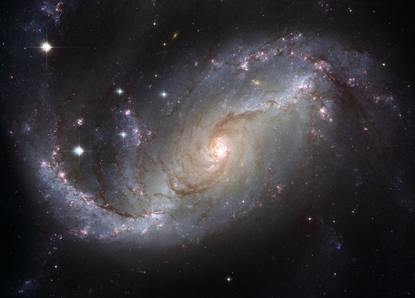|
I wrote a post regarding how our experience can mislead us into assuming certain things to be true. I came across an even more remarkable example that caught me by surprise, and I want to share it with you, not just because it is very interesting, but also because many people get the explanation wrong. We all know that air bubbles released underwater rise to the top because air is less dense than water, right? We all know that hot air rises and cold air sinks because hot air is less dense than cold air, right? When things are exposed to a medium that is denser than they are, these things tend to rise and are said to be buoyant. This is our everyday experience, this is common sense. In what possible situation could this not be true? On Earth we take buoyancy for granted, but we seldom think about the role that gravity and its opposing forces play in determining buoyancy. Let’s imagine a sealed plastic cylinder with water, standing on the ground. If we release a bubble at the bottom of the cylinder, the bubble will float up as expected. We say this happens because the bubble is made up of air which is less dense than water, but we need to understand better why this happens in more detail. Under the influence of gravity, the water inside the cylinder is pulled down towards the Earth and exerts a pressure against the walls of the cylinder. In turn the walls of the cylinder exert a pressure against the water that counteracts the gravitational pull. This pressure that opposes gravity is not equal along the length of the cylinder. An object at the bottom of the cylinder will experience the full weight (pull of gravity) of the whole column of water inside the cylinder and will experience a counter pressure of equal magnitude, whereas an object halfway up the cylinder will only experience half of the weight of the column of water and will experience half of the counter pressure. So there is what is called a pressure gradient along the length of the cylinder, with bottom being maximum pressure and top being minimum pressure. If you have ever swum to the bottom of the deep end of a pool, the feeling you got in your eardrum is due to the greater pressure at the bottom. So an object like a cork or a water bubble rises, not just because it is less dense, but because the pressure at its bottom end is greater than the pressure at its top. It is the pressure differential across the top-down axis of the object that makes it rise, and (this is key) what makes possible this pressure differential is the simultaneous application of both the force of gravity and the forces that oppose gravity (the pushing of the wall of the cylinder against the water). Now imagine we place the cylinder high up in the air on a platform with a trapdoor. Gravity pulls on the cylinder and the platform generates a force that opposes the pull of gravity. This force is transmitted to the cylinder and counters the pull of gravity on the water. Now imagine we release a bubble at the bottom of the cylinder as before, but this time we open the trapdoor making the cylinder fall. What will the bubble do? Will it rise to the top of the cylinder as before? In the video below you can see an attempt at answering this question here on Earth. The authors of the video released bubbles at the bottom of a sealed container and dropped it. The experiment is not perfect as there are issues with respect to the friction generated by the air on the container that antagonize to a certain extent the force of gravity, but you can clearly see at 2 minutes and 45 second into the video that some bubbles at the bottom of the container cease to rise (cease to be buoyant) when the container is dropped. However, the video ascribes this effect to a cessation of gravity, which is not true. A better way to perform this experiment is to release an air bubble inside a mass of water in a free-falling object like the international space station (ISS). As you can see in the video below, at 1 minute and 33 seconds, the air bubbles indeed don’t “rise” inside the blob of water. This effect is also observed when air, instead of water, is involved. Consider a lit candle here on Earth. As the candle burns, it heats the air in the vicinity of the wick. This air expands, becomes less dense, and is pushed up by the surrounding cooler denser air (much in the same way as the water molecules in the cylinder push against the air bubble). The pressure the cooler air exerts on the warm air at the bottom of the candle flame is higher than at the top of the flame, thus the warm air rises. This brings a stream of cool air, and therefore more oxygen, into the bottom part of the candle to repeat the cycle and maintain the flame: a process that is called buoyant convection and which gives candle flames their characteristic elongated shape. But this process only works because cool air accumulates on the surface of the Earth pushing against warm air and opposing gravity (much like the walls of the cylinder push against the water inside it). In a free-falling object, such as the international space station, there is no force to oppose gravity, and the cool air does not push against the warm air, which means that buoyant convection cannot feed oxygen to the flame. Because of this, the candle relies on simple diffusion (movement of a substance down its concentration gradient) of oxygen from the surroundings to maintain the flame, a process that is much slower. As a result, any candles lit in the International Space Station will display a round shape, burn much less vigorously, and tend to snuff themselves out. The important thing to understand (despite the use of words like “zero gravity” or “microgravity” in many of the videos and posts that endeavor to explain this effect) is that gravity is not impaired and doesn’t cease to exist. Think about it. The relevant gravitational force involved in these experiments is that of the Earth. For gravity within this context to cease to exist, the Earth would have to disappear! The reason buoyancy ceases in the International Space Station in space, or is impaired in the free falling cylinder here on Earth, is that gravity is not antagonized in these conditions. Buoyancy requires both gravity and the presence of an opposing force. In a free falling object gravity is unopposed; it is the only force acting upon the object. Therefore, because there is no force to push against gravity, the pressure gradient required to generate buoyancy is not produced. So you see, three things are required for an object to float freely: 1) Gravity, 2) A force that opposes gravity, and 3) the object having a lower density than the medium surrounding it. Remember, it takes 3 to buoyango.* *Well, I think it’s clever. Flame on Earth and Zero G by 2il org used here under an Attribution 2.0 Generic (CC BY 2.0) license.
0 Comments
The creationist movement has changed strategies. Many of their adherents have become proponents of what is called “Intelligent Design”. Within creationist circles, the Intelligent Design movement is mostly considered a strategy to make inroads into the secular world of science. In transitioning to Intelligent Design many of its proponents accept that the Earth is billions of years old, that there is no geological evidence of a worldwide Universal Flood, and that populations of living organisms have the capacity for microevolution, which is the ability to adapt to changes in the environment. However, although Intelligent Design proponents accept that microevolution allows organisms to adapt and develop new abilities, they disagree with the idea that microevolution can give rise to evolutionary novelty, and they employ various strategies to explain away many of the numerous examples in the scientific literature where this has been documented. One strategy is to argue that these cases of generation of evolutionary novelty represent nothing but the mere reshuffling of preexisting genetic information. This argument is somewhat baffling as it is akin to saying that a new book is not really new because it is merely a reshuffling of words already present in previous books. But because more than reshuffling is often involved as random mutations are selected that improve certain abilities, Intelligent Design proponents have also argued that a Designer created the capacity in organisms to mutate information, reshuffle it, and adapt to changes in their environment! And, of course, if all else fails, Intelligent Design proponents will argue that the novelty in question is not a real novelty, that it is only a minor change, and therefore it is not evolution but rather just merely “adaptation”. Despite their acceptance of microevolution, the Intelligent Design movement denies that macroevolution can take place. Macroevolution is large scale changes that produce novelty like the transition from reptiles to birds, or from land dwelling animals to sea dwelling animals. Scientists tell Intelligent Design proponents that macroevolution is what you get if you let microevolution go on for millions of years, but Intelligent Design proponents disagree. A favorite Intelligent Design argument is that nobody has ever observed macroevolution. And this is obvious, of course, because macroevolution is a slow process that takes many millions of years. However, various lines of evidence including the fossil record have allowed scientists to demonstrate quite convincingly that macroevolution has indeed occurred. But, of course, Intelligent Design proponents have several clever retorts. For example, if there are no fossil intermediates between organisms “A” and “C”, Intelligent Design proponents will point this out claiming that “C” appeared suddenly (was designed) as opposed to evolving from A. However, if a fossil intermediate is found, “B”, Intelligent Design proponents will reply that there are no intermediates between “A” and “B”, and between “B” and “C”! Nothing but the discovery of highly detailed fossils documenting gradual change between two organisms will convince them that evolution has taken place. The obvious problem with this is that such highly detailed evidence may not be possible given the dynamics of the processes of fossilization and speciation, and the sizes of the populations of organisms involved in the process. In any case, why should the intermediate be an intermediate? After all it could be a different organism that was intelligently designed and that just happened to share characteristics of the other two!  In the elaboration of their criticism of evolution, Intelligent Design proponents also argue for the premise that they call “irreducible complexity”. What this means is that complex biological structures are composed of many parts each of which is necessary for their function. Therefore, they argue, a structure will not acquire its proper function unless all components are present and functional. Thus it is impossible for these structures to have evolved by accumulating their constituent parts because the assembly of these components into non-functional structures (at least until the last component is added and the whole becomes functional) would not be selected because they confer no advantage. To illustrate this principle, Intelligent Designers select structures that leave no fossil record such as bacterial flagella (a structure that allows bacteria to propel themselves) and demand that evolutionists come up with explanations as to how they could have evolved. Evolutionists have duly responded by pointing out several ways in which bacterial flagella could have evolved from simpler structures. But Intelligent Designers are not impressed. As described in the previous paragraph, they expect exhaustive step by step descriptive explanations of how these systems evolved, and when the ones provided don’t meet their demands, they declare a win for Intelligent Design. So we can only arrive at one conclusion. Intelligent Design has been intelligently designed! The strategy is clear. First, bite the bullet and accept some of the most obvious things like geological and astronomical evidence for an old Earth and microevolution (there will be time to come back to a literal interpretation of Genesis later). Second, concentrate your attacks on those aspects of evolutionary theory that can only be studied through fragmentary evidence, such as events that have occurred in the distant pass, or indirect evidence, such as those involving structures that leave no fossil record. Finally, demand a level of proof that is incompatible even with the best possible evidence that could be generated.
As an offshoot of creationism, Intelligent Design has been tailored to achieve one goal, and that is to discredit evolution and endow with academic respectability the notion that a designer is behind the appearance of new life forms in our world. Of course, when your ideas cannot be proven wrong even with the best possible evidence, then your ideas are not scientific, and with all of its twisting and turning around the evidence, Intelligent Design cannot hide this fact. The image from Pixabay by sbtlneet is used here under a CC0 Creative Commons license. Some people claim science is a killjoy. Why measure and analyze and classify everything? Why try to figure out how everything works? Why can’t scientists let nature be and enjoy it without dissecting it apart and figuring out what makes it tick? Are scientists spending too much time locked away in labs to relate to the world like normal people? And even those that do get out and interact with nature, shouldn’t they stop viewing everything through the prism of ecosystems and niches and predator-prey relationships and whatnot? I have to strongly disagree with this notion. From my vantage point, science vastly enriches our enjoyment of the world and greatly magnifies the sense of awe that we can feel.  Consider a mighty peak like Mount Everest. Imagine you are at the foot of the mountain and you tilt your head back so much that your neck hurts. You can see the great rocky summit reared against the arc of the sky gleaming in the sun sporting a plume of wind-swept snow. The highest point in the planet is so beautiful and majestic. Now allow me to quote what nature writer John McPhee wrote in his book Annals of the Former World: “When the climbers in 1953 planted their flags on the highest mountain, they set them in snow over the skeletons of creatures that had lived in the warm clear ocean that India, moving north, blanked out. Possibly as much as twenty thousand feet below the seafloor, the skeletal remains had formed into rock. This one fact is a treatise in itself on the movements of the surface of the earth. If by some fiat I had to restrict all this writing to one sentence, this is the one I would choose: The summit of Mt. Everest is marine limestone.” That lofty pinnacle up there was once part of a sea bottom! This knowledge expands our capacity for enjoying the beauty of Everest and its significance. And it’s not just Mount Everest. Every mountain, every hill, every rock outcrop has a fascinating geologic story behind it. The landscapes all around us are ephemeral instants of geologic time where mountains reach for the sky and are eroded to the ground for eternity.  Suppose you go to the zoo with your family. You stare in amazement at the elephants, giraffes, rhinoceroses, hippopotamuses, pandas, lions, tigers, antelopes, apes, and other animals. Such diversity of sizes and body shapes, such colors, such beauty. All these living things form part of the tapestry of life. How many stories and paintings have they inspired? But as it turns out, we are part of the weave! Scientists have discovered that all these animals, including us, arose on this planet through a process of evolution which means we all share common ancestors. So when you peer into the eyes of a chimpanzee, you are looking back to the dawn of our species because they are one of our closest relatives.  Now imagine it’s nighttime and you are in the country far away from the lights of the city. You stare at the sky and see the myriad of stars, the diffuse cloud of our galaxy the Milky Way, and perhaps even a planet or two. Those marvelous worlds and suns so far removed from us. How many songs, and poems, and stories have they inspired? Now allow me to quote what the late astronomer Carl Sagan said in his famous program Cosmos: “The nitrogen in our DNA, the calcium in our teeth, the iron in our blood, the carbon in our apple pies were made in the interiors of collapsing stars. We are made of star stuff.” Yes, the components of your body and in fact of all life on Earth were created “up there” billions of years ago by some of the most titanic explosions that the universe has ever produced. Doesn’t that blow your mind away?  Finally, imagine being able to create reality by the mere act of observing it. Imagine an entity that can be a wave and a particle at the same time, that can be in two different places simultaneously, or that appears to go back in time. Imagine split realities, multiple universes, spooky actions at a distance, and a cat that is both dead and alive. These are some of the bizarre or counterintuitive phenomena and ideas generated by quantum mechanics. Quantum Mechanics is the highly successful theory ushered into existence by individuals that have become the stuff of legend such as Bohr, Planck, Einstein, Heisenberg, and Schrödinger, and which has made possible computers, smartphones, the internet, GPS, and MRI. Many scientific theories have challenged specific beliefs that humans beings harbored regarding their surroundings, but quantum mechanics has called into question our most basic notions of matter, space, and time, generating amazing realms where fantasy seemingly merges with realty, and where we can wander and wonder. These discoveries, and many others that have opened our senses and imagination to the hidden secrets of our planet and the universe, were only possible thanks to generations of researchers who spent years of their lives in offices, labs, or in the field thinking, measuring, analyzing, classifying, and performing experiments. These scientists were awed by their discoveries, and they have generated inspiration for poets, painters, writers, photographers, musicians, filmmakers, sculptors, and many others. Are you ready to be inspired? Learn about science! Schrodinger's Cat by Jie Qi is used here under an Attribution 2.0 Generic (CC BY 2.0) license, Everest photo credit: Rupert Taylor-Price / Foter.com / CC BY, Galaxy (CC0), Chimpanzee photo by Afrika Force is used under an Attribution 2.0 Generic (CC BY 2.0) license.  The scientific consensus has been getting a bad rap lately. Some people argue that whether science is right or not about an issue is not decided by majority vote. Rather, it is claimed, it only takes one scientist to be right to decide whether the science regarding an issue is true or not. Those that make this argument then go on to provide a list of scientists that went against the consensus and prevailed. The people making these argument then proudly proclaim that in science there is no such thing as consensus, that science does not require a consensus, and if there is a consensus, then it isn’t science! Let’s try to understand a few things about the scientific consensus.
A scientific consensus is not reached when scientists get together and “vote”. A scientific consensus, unlike the use of this word in other fields such as politics, does not involve a compromise. Also the word consensus is sometimes used to denote the current state of a field as in “the current consensus”. In a new field of study the term “scientific consensus” really means “the current opinion” and it is understood that such opinion is very likely to be overturned in the future. This is not the meaning of consensus that better serves science in the public sphere when dealing with topics like climate change or evolution. The meaning of scientific consensus that we should seek is that consensus attained in a field of science that is backed by a fully developed scientific theory. A field of science that has not generated a fully developed scientific theory is incapable of generating a true scientific consensus. The reason this is the case is because a fully developed scientific theory has grasped important aspects of reality in its formulation and is likely to have a high degree of completeness. How is such a theory developed? When a field of study is in its early stages, scientists from several countries, ethnic backgrounds, beliefs, political persuasions, etc. begin tackling a problem. All these scientists bring their intellect and life experience to bear on answering the questions being investigated. Initially there is a multiplicity of possible answers, there are uncertainties, deficiencies and limitations in the methodologies, and there is confusion. Many scientists go down blind alleys only to find they have wasted their time on a wrong approach and have to turn back. Some explanations emerge that seem to be better than others. Methodologies are improved. Hypotheses are refined. Exceptions are explained. Scientists from other areas enter the field and bring new tools and ideas (a very important development). The research performed in these other fields is found to be complementary to the research in the emerging field. Eventually as the field matures scientists from different laboratories using different methodologies begin obtaining the same results and elaborate models that they use to make predictions (another very important development). Some predictions are not fulfilled and the models that generated them fall by the wayside and are replaced by new models that are more accurate at explaining the data and making new predictions. Eventually the field coalesces around a theory. The theory is used to generate practical applications and to explain observations in other areas of science. A theory developed through the process described above is not an ephemeral construct that can be overturned at any time. The very technology that we use in our everyday lives depends on hundreds of solid scientific theories that have never been disproven. Many people who do not understand the nature of scientific truth confuse the overturning of a scientific theory with its refinement. This is because there is the erroneous notion that scientific theories should explain everything, and this is not the case. A scientific theory only has to answer the most important questions raised by scientists. Thus, when a fully developed scientific theory is produced in a field of study this means that scientists have stopped arguing with each other about the salient points addressed by the theory. In other words, they have reached a consensus. This is the true meaning of a scientific consensus. Of course, the fact that there is a consensus doesn’t mean that everything has been settled. Scientists that agree with evolution are still debating how evolution happens. Scientists that agree with climate change are still debating its extent and mechanisms. Nevertheless, a consensus does mean that the major overreaching question in the field has been answered to the satisfaction of the vast majority of the scientists involved in the research. The consensus can, in principle, be modified if the underlying theory that backs the consensus is found to be incomplete, but this is only true if the refinements to the theory in the form of new observations, new data, or new interpretations of old data or old observations, significantly modify those parts of the theory that are vital for the consensus. In the case of a fully developed scientific theory this is no easy task, and the burden of proof is on those who seek to modify the theory. Some people claim that this promotes a herd mentality that leads to dissenting scientists being penalized and those that are compliant being rewarded resulting in the discouragement of innovation. However, what has to be understood is that science is a very conservative enterprise that sets a very high bar for those seeking to challenge what is considered established knowledge. If you are going against the prevailing theory, you’d better have very good evidence. This is not the product of a herd mentality or a way to discourage innovation: it is a way of protecting established science against error. In the public debate, when you hear that a consensus has been reached in a particular field of science, you need to ask about the nature of the underlying theory that backs it. If the theory fulfils the requirements of a fully developed scientific theory, then the consensus is good. A consensus is only as good as the theory that supports it. However, suggesting that there is no such thing as a scientific consensus or that it is irrelevant is nothing more than a strategy to delegitimize science. It has been used in the past by entities such as the cigarette lobby, and it is being used today by creationists, climate change deniers, and other groups that seek to further their anti-science agendas. Image by Nick Youngson used here under an Attribution-ShareAlike 3.0 Unported (CC BY-SA 3.0) license. |
Details
Categories
All
Archives
June 2024
|

 RSS Feed
RSS Feed